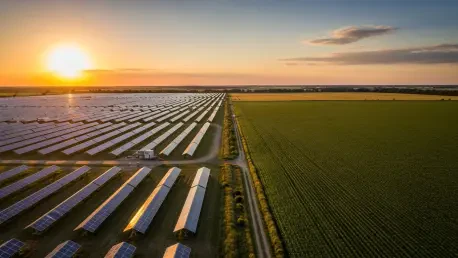In the rolling fields of Staffordshire, a quiet but pressing conflict is unfolding between the urgent drive for renewable energy and the fundamental need to protect agricultural land for food production, raising critical questions about balancing national energy goals with ensuring food security for future generations. Farmers, local leaders, and rural communities are grappling with an unprecedented wave of pressure as developers aggressively pursue farmland for solar farms and battery energy storage systems. While renewable energy is undeniably vital in combating climate change, the rapid conversion of fertile land into energy infrastructure is sparking concerns that rural areas are disproportionately bearing the burden of these initiatives. As this issue gains traction, stakeholders are calling for a strategic approach to harmonize these competing priorities, ensuring that neither energy nor agriculture is sacrificed in the pursuit of sustainability.
Balancing Energy Needs with Agricultural Priorities
The surge in demand for renewable energy projects has placed Staffordshire farmers under immense strain, with many receiving relentless solicitations from developers eager to transform their land into solar farms. Councillor Andrew Mynors, a prominent figure in Staffordshire County Council, has highlighted the significant stress this causes for farmers who are already stretched thin by the demands of food production. These daily interruptions not only disrupt their focus but also force difficult decisions about whether to sell land that has often been in families for generations. The lack of a clear national framework exacerbates this issue, leaving rural communities feeling unsupported as they navigate offers that promise financial security but threaten their primary livelihood. This scenario underscores a broader challenge: without a cohesive policy, the push for green energy risks undermining the very foundation of local food systems, creating ripple effects that could impact regional and national food supplies.
Beyond the personal toll on farmers, the broader implications of converting farmland into energy sites are becoming increasingly apparent in Staffordshire. Local authorities, under the Reform UK administration, are voicing strong opposition to the unchecked expansion of large-scale solar projects on agricultural land. The county farms estate, a vital resource for sustaining rural economies, is at the heart of this resistance, with leaders advocating for its preservation over renewable energy development. Councillor Chris Large, responsible for finance and resources, has emphasized the importance of utilizing farm buildings for solar panels as a compromise that reduces carbon footprints without sacrificing productive land. This approach reflects a growing consensus that while renewable energy is essential, its implementation must be carefully managed to avoid long-term damage to agriculture. The ongoing dialogue reveals a critical need for policies that prioritize both energy innovation and the protection of rural landscapes.
Local Resistance and Calls for National Strategy
Staffordshire’s local leaders are not alone in their concerns, as discussions with key agricultural bodies reveal a shared commitment to safeguarding farmland. At events like the English Winter Fair, deputy leader Councillor Martin Murray engaged with representatives from the National Farmers’ Union (NFU) to address the mounting pressure on rural areas. These conversations underscored a unified stance against the conversion of high-quality agricultural land into energy infrastructure, with a focus on finding alternative solutions that do not compromise food production. The resistance to large-scale solar farms and battery storage systems on fertile soil is rooted in a deep understanding of the long-term consequences for food security. As urban areas contribute less to renewable energy development, rural communities feel increasingly burdened, prompting calls for a more equitable distribution of energy projects. This growing frustration highlights the urgent need for a national strategy that addresses these disparities and protects vital agricultural resources.
Adding depth to this perspective, the NFU offers a balanced view through county advisor Jeremy Lowe, who acknowledges the potential benefits of solar farms as a source of diversification income for farmers. However, this must be carefully aligned with food production goals to avoid detrimental impacts on the agricultural sector. National planning guidance supported by the NFU advocates for situating large-scale solar developments on lower-quality land, thereby preserving the most fertile soils for farming. Additionally, there is a strong push to incentivize the installation of solar panels on farm building roofs, a solution that minimizes land use conflicts while still contributing to renewable energy targets. The cumulative impact of these projects on rural communities remains a significant concern, as unchecked development could disrupt local economies and ways of life. This nuanced stance reflects the complexity of integrating renewable energy into rural landscapes without sacrificing their primary function.
Charting a Sustainable Path Forward
Reflecting on the challenges faced by Staffordshire’s rural communities, it becomes evident that the aggressive pursuit of farmland for solar farms has created a palpable tension between energy ambitions and agricultural needs. The persistent harassment of farmers by developers, coupled with the protective stance of local authorities, paints a picture of a region under strain. The NFU’s advocacy for balanced solutions, such as prioritizing lower-quality land for energy projects, offers a glimpse of hope amid the uncertainty. Looking back, the unified call for a comprehensive national policy stands out as a critical turning point in addressing these intertwined issues. Moving forward, stakeholders must collaborate to develop actionable frameworks that integrate energy and food security goals. Encouraging solar installations on non-agricultural spaces and ensuring equitable land use policies between urban and rural areas could pave the way for sustainable progress. This multifaceted approach promises to mitigate past conflicts and foster a future where both renewable energy and agriculture thrive in harmony.









